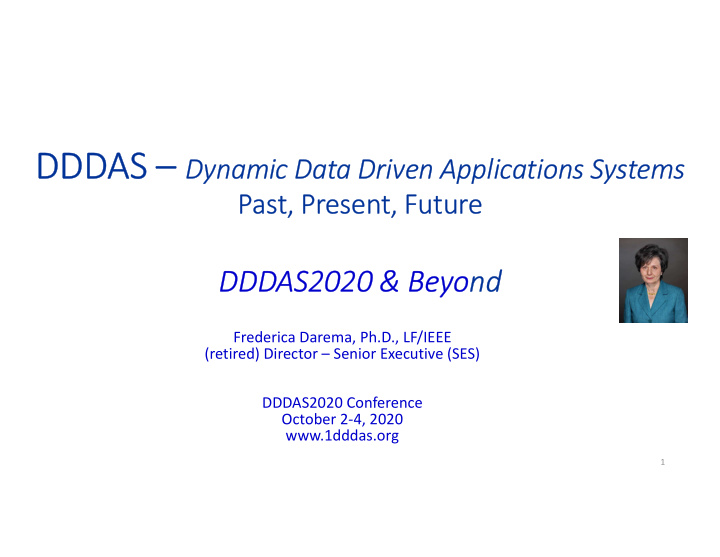



DDDAS – Dynamic Data Driven Applications Systems Past, Present, Future DDDAS2020 & Beyond Frederica Darema, Ph.D., LF/IEEE (retired) Director – Senior Executive (SES) DDDAS2020 Conference October 2-4, 2020 www.1dddas.org 1
Welcome to the DDDAS2020 Conference Conference Co-Chairs: Dr. Frederica Darema and Dr. Erik Blasch Program Co-Chairs: Dr. Alex Aved, Prof Sai Ravela, Dr. Murali Rangaswamy Program Committee: • Robert Bohn (NIST) • Richard Linares (MIT) • Newton Campbell (NASA and SAIC) • Dimitri Metaxas (Rutgers Univ) • Nurcin Celik (U of Miami) • Jose Moreira (IBM) • Ewa Deelman (USC/ISI) • Chiwoo Park (FSU) • Salim Hariri (U of Arizona) • Sonia Sachs (DOE) • Thomas Henderson (U of Utah) • Ludmilla Werbos (U of Memphis) • Artem Korobenko (U of Calgary) • Themistoklis Sapsis (MIT) • Fotis Kopsaftopoulos (RPI) • Amit Surana (UTRC) Agenda: Keynotes, Plenaries, Posters, Panels 2
DDDAS Initiative Launched (March 2000) DDDAS (Dynamic Data Driven Applications Systems) DEFINTION of DDDAS (2000/NSF Workshop) InfoSymbiotic Systems DDDAS: ability to dynamically incorporate additional data into an executing application, and in reverse, ability of an application to dynamically steer the measurement process Challenges : Application Modeling/Simulations Methods Algorithmic Stability Measurement/Instrumentation Methods Computing Systems Software Support Instrumentation -> Synergistic, Multidisciplinary Research Observation/Actuation Dynamic Capabilities : Feedback & Control more accurate understanding/prediction systems characteristics/behaviors Loop speeding-up simulation/modeling, by replacing computation with instrumentation data in specific parts of the phase-space of the model improve accuracy of the model by augmenting the model with actual data to improve analysis/prediction capabilities of application models dynamically manage/schedule/architect heterogeneous resources (2000/NSF Workshop) networks of heterogeneous sensors or controllers detect and mitigate sensor failures Dynamic Integration of Computation & Measurements/Data enable decision-support capabilities with simulation/modeling accuracy Unification of Computing Platforms & Sensors/Instruments (from the High-End to the Real-Time, to the PDA) 3 DDDAS – > architecting & adaptive management of sensor systems
DDDAS Development Large-Scale-Big-Data Large-Scale-Big-Computing QVO VADIMUS AFOSR-NSF Program AFOSR NSF Program Workshop 2016 DDDAS AFOSR-NSF NSF DDDAS 2014 Workshop Workshop NSF DDDAS Program InfoSymbiotic 2011 DDDAS 2010 DDDAS term coined NSF/ITR 2006 ( symbiotic systems ) 2005 NSF/NGS 2000 2003 IBM; UTC; DARPA Program ASME Performance Gedanken Engineering Idea 1999 Laboratory 1998 spawned 1996 1980 1984-86 4
Example Highlights of DDDAS Impact • 2000 - Kelvin Droegemeier – Adverse Weather /Tornadic activity – LEAD project: Users INTERACTING with Weather March 2000 Fort Worth Interaction Level II: Tools and People Driving Tornadic Storm Local TV Station Radar Observing Systems – Dynamic Adaptation (Slide – Courtesy K. K. Droegemeier) NWS National Static Observations & Grids Tornado Virtual/Digital Resources and Services Users Mesoscale ADaM ADAS Experimental Dynamic Tools Weather Remote Physical (Grid) Observations Resources Local Physical Resources “ Sensor Networks & Computer Networks ” Local Observati on s NEXRAD CASA Slide courtesy Droegemeier 2010 - Tinsley Oden – showed predicting on-set in materials damage before visible 2011 – Nurcin Celik - Powergrids Real-time Decision Support - Renewable Resources – multiple consumer classes&priorities 2012 – Karen Willcox – Real-Time Decision Support for aerial platforms - Structural Health Monitoring and Mission Planning Potential examples (DDDAS-based solutions): • Tree-tomography • Future aircraft designs (Dutch V-shaped – DelftU -KLM) (WashDC Sculpture Garden) 5
Examples of Areas of DDDAS Impact from the nano-scale, to the tera-scale, to the extraterra-scale • Materials – Fundaments & Design DDDAS/InfoSymbiotics drives: • Structural Health Monitoring • Foundational methods • Advanced Manufacturing Filtering, Estimation, • Smart Civil Infrastructures Machine Learning • Transportation Uncertainty Quantification • Power-grids • Applications approaches • Water Distribution systems-of-systems • Smart Cities representation models • Ecological Systems network control sensor management • Smart Agriculture • Atmospheric Weather DDDAS has influenced extensions: • Adverse events Data Assimilation • Hurricanes Digital Twin • Tornadoes GANs • Earthquakes • Environmental Disasters Recent/emerging ML algorithms • Wildfires apply and/or adopt the essence the • Oil Spills DDDAS paradigm • Earthquakes Informative Sensing, Estimation, Planning • Space Weather Targeted Observation, Active Learning • Land, Air, Space Reinforcement Learning RelevanceFeedback • Emergency Response Stochastic Modeling, Feature Selection AFOSR-NSF 2010 Report (www.1dddas.org) • Resource Planning Recommender Systems, etc Other initiatives, such as: • Supply-Chain Logistics Cyber-physical Systems (NSF 2006) • Model-based Real-time Decision Support can benefit from the more comprehensive -> Autonomic Systems approaches of the DDDAS paradigm 6
QUO VADIMUS Moving into the future there is a confluence of needs and technological advances: Increasingly we deal with systems-of-systems & systems/environments that are complex | heterogeneous | multimodal | multiscale | dynamic Need to understand characteristics/behaviors: design – operation – evolution – interoperability – maintenance -- lifecycle Ad-hoc methods are not enough – need modeling not only for design but entire file-cycle Data alone is not enough Data is not the 4 th paradigm… - Data is the primordial paradigm Data Analytics is not enough - We need Systems Analytics ML alone is not enough -> …. Models Data …. DDDAS/InfoSymbiotics has shown: comprehensive, principle-based models rendered more efficient and accurate understanding, prediction, and real-time decision support with the accuracy of full-scale models dynamic and adaptive coordination of heterogeneous resources abilities, and ensuring fault tolerance DDDAS/InfoSymbiotics - timely now more than ever: increased emphasis in complex systems multi-scale/multi-modal modeling/algorithmic methods ubiquitous sensing, networks of heterogeneous collections of sensors/controllers large-scale-big-computing – large-scale-big-data; increased computation and communication capabilities enable and exploit these capabilities Some New Opportunities Areas: Test&Evaluation: embedded sensors&actuators (physical and software); additive manufacturing DDDAS-based adaptivity to improve performance, system evolution adaptivity – interoperability - maintenance; No longer limited to the design (“breadboarding”) cycle – T&E become a lifecycle process 5G&Beyond: 7 DDDAS-based methods for adaptive coordination of heterogeneous resources; optimization of performance, energy, QoS
Recommend
More recommend